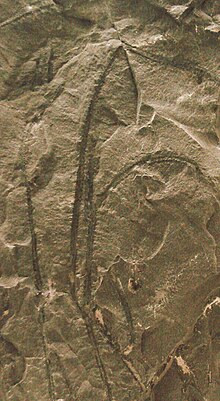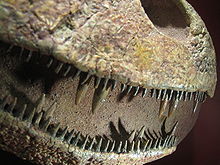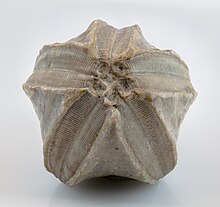Portal:Devonian
The Devonian Portal
The Devonian (/dəˈvoʊni.ən, dɛ-/ də-VOH-nee-ən, deh-) is a geologic period and system of the Paleozoic era during the Phanerozoic eon, spanning 60.3 million years from the end of the preceding Silurian period at 419.62 million years ago (Ma), to the beginning of the succeeding Carboniferous period at 358.86 Ma. It is the fourth period of both the Paleozoic and the Phanerozoic. It is named after Devon, South West England, where rocks from this period were first studied.
The first significant evolutionary radiation of life on land occurred during the Devonian, as free-sporing land plants (pteridophytes) began to spread across dry land, forming extensive coal forests which covered the continents. By the middle of the Devonian, several groups of vascular plants had evolved leaves and true roots, and by the end of the period the first seed-bearing plants (pteridospermatophytes) appeared. This rapid evolution and colonization process, which had begun during the Silurian, is known as the Silurian-Devonian Terrestrial Revolution. The earliest land animals, predominantly arthropods such as myriapods, arachnids and hexapods, also became well-established early in this period, after beginning their colonization of land at least from the Ordovician period.
Fishes, especially jawed fish, reached substantial diversity during this time, leading the Devonian to be called the Age of Fishes. The armored placoderms began dominating almost every known aquatic environment. In the oceans, cartilaginous fishes such as primitive sharks became more numerous than in the Silurian and Late Ordovician. Tetrapodomorphs, which include the ancestors of all four-limbed vertebrates (i.e. tetrapods), began diverging from freshwater lobe-finned fish as their more robust and muscled pectoral and pelvic fins gradually evolved into forelimbs and hindlimbs, though they were not fully established for life on land until the Late Carboniferous. (Full article...)
Selected Devonian Article
The list of Early Devonian (419.2 ± 2.8 to 393.3 ± 2.5 million years ago) land plants includes currently known vascular and potentially vascular plants, along with some possibly non-vascular plants, that have been described from global Early Devonian fossil assemblages. (Full article...)
List of selected Devonian articles
|
|---|
Selected Devonian land plant article
Trimerophytopsida (or Trimeropsida) is a class of early vascular plants from the Devonian, informally called trimerophytes. It contains genera such as Psilophyton. This group is probably paraphyletic, and is believed to be the ancestral group from which both the ferns and seed plants evolved. Different authors have treated the group at different taxonomic ranks using the names Trimerophyta, Trimerophytophyta, Trimerophytina, Trimerophytophytina and Trimerophytales. (Full article...)
List of selected Devonian articles
|
|---|
Selected Devonian formation
Old Red Sandstone, abbreviated ORS, is an assemblage of rocks in the North Atlantic region largely of Devonian age. It extends in the east across Great Britain, Ireland and Norway, and in the west along the eastern seaboard of North America. It also extends northwards into Greenland and Svalbard. These areas were a part of the paleocontinent of Euramerica (Laurussia). In Britain it is a lithostratigraphic unit (a sequence of rock strata) to which stratigraphers accord supergroup status and which is of considerable importance to early paleontology. The presence of Old in the name is to distinguish the sequence from the younger New Red Sandstone which also occurs widely throughout Britain. (Full article...)
List of selected Devonian formation articles
|
|---|
Selected Devonian fish article
Tristichopterids (Tristichopteridae) were a diverse and successful group of fish-like tetrapodomorphs living throughout the Middle and Late Devonian. They first appeared in the Eifelian stage of the Middle Devonian. Within the group sizes ranged from a few tens of centimeters (Tristichopterus) to several meters (Hyneria and Eusthenodon).
Some tristichopterids share some of the features of the elpistostegalians, a diverse clade of tetrapodomorphs close to the origin of (and including) tetrapods.[better source needed] This mainly concerns the shape of the skull and a reduction in size of the posterior fins.
An old and persistent notion is that Eusthenopteron was able to crawl onto land using its fins. However, there is no evidence actually supporting this idea. All tristichopterids had become extinct by the end of the Late Devonian. (Full article...)
Selected Devonian invertebrate
Blastoids (class Blastoidea) are an extinct type of stemmed echinoderm, often referred to as sea buds. They first appear, along with many other echinoderm classes, in the Ordovician period, and reached their greatest diversity in the Mississippian subperiod of the Carboniferous period. However, blastoids may have originated in the Cambrian. Blastoids persisted until their extinction at the end of Permian, about 250 million years ago. Although never as diverse as their contemporary relatives, the crinoids, blastoids are common fossils, especially in many Mississippian-age rocks. (Full article...)
List of selected Devonian invertebrates articles
|
|---|
Need help?
Do you have a question about Devonian that you can't find the answer to?
Consider asking it at the Wikipedia reference desk.
Subcategories
Related portals
Associated Wikimedia
The following Wikimedia Foundation sister projects provide more on this subject:
-
Commons
Free media repository -
Wikibooks
Free textbooks and manuals -
Wikidata
Free knowledge base -
Wikinews
Free-content news -
Wikiquote
Collection of quotations -
Wikisource
Free-content library -
Wikiversity
Free learning tools -
Wiktionary
Dictionary and thesaurus



























